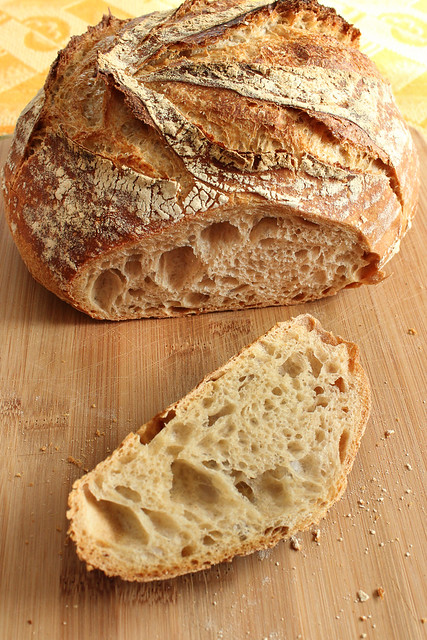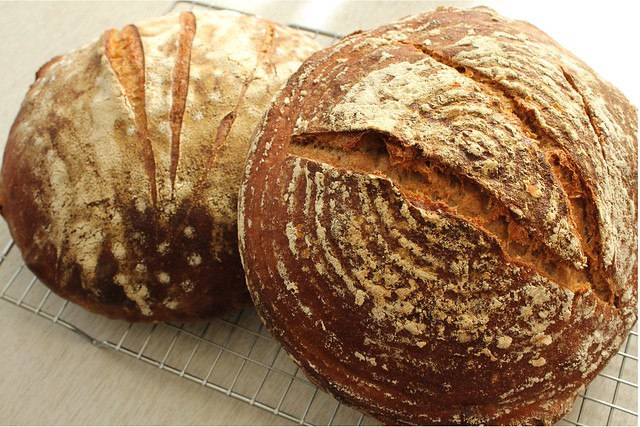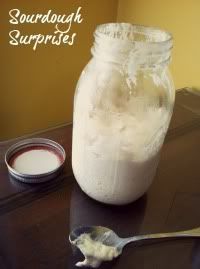I'm only speaking from a amateur perspective, but it does seem that all the best breads are baked in the fall. In the past few years that I've been mothering the sourdough culture, autumnal air seems to be my most trusted ally in getting the most impressive results. I like to think it has to do with less ambient moisture, and maybe a more seasonal reason for firing the oven (even though the heat of summer does nothing to stop me), but it's quite possible it's just luck. Just in case, I had to detail the loaves that came from my kitchen last week, the ones still under the glass dome on my counter aging gracefully, the ones that still surprise me and make me feel like a bona fide baker.
I lowered the water content intentionally and increased the whole wheat content in the Ken Forkish method bread I've most favored for about the past 6 months. I got out my calculator, and figured it at 72% hydration. An approximate amount since my bread begins with 100% hydration starter that is well fed and converted some 6 hours before into a near 80% hydration starter. I'm not math savvy enough to figure the degrees of difference. 72% is close enough for me, and dense enough to stand up to some artful slashing, which was my hope. This bread was pure perfection; I have to say, I was so proud.
The baking notes:
6-8 hours before mixing the dough, build the 80% levain:
Then to build bulk dough:
The baking notes:
6-8 hours before mixing the dough, build the 80% levain:
- 25 g. (100% hydration) starter
- 25 g. whole wheat flour
- 100 g. ap flour
- 100 g. water at 90 degrees.
Then to build bulk dough:
- 100 g. whole wheat flour
- 300 g. ap flour
- 280 g. water (90-95 degrees)
- 2 t. kosher salt
- 1/4 t. instant yeast
- 210 g. of the levain (almost all of the levain from above)
This success was early on last week, before my Mom visited. I like to plan on baking just before she leaves so she can take a fresh loaf home with her. I was slightly frazzled when it came time to do my mixing, and I had a complete accident that worked out unbelievably to my advantage. I had pre-measured my flours before she arrived, thinking I'd save myself a few minutes when it came time to build the bread. But... when I went to add my carefully measured amount, I mistakenly grabbed the container of whole wheat flour next to the measured flours, and emptied the whole of it into my mixing bowl. As I mixed in the water it felt stiff and different, and it took me a few minutes to realize what I did. My Mom thought I should just go ahead and try building with it since I'd be wasting ingredients anyway if I didn't try... and it turned out to be one of the best mistakes ever. Two loaves of nearly 100% whole wheat sourdough that didn't feel leaden or too dense, just wonderfully wheaty tasting.
I had already mixed up the 80% levain I mentioned above, and I added it to the autolysed dough of a mystery amount of whole wheat flour and base water amount of 280g. I knew it would need more water, and added it by feel after the autolyse, working it by hand perhaps a bit more than with properly ratio-ed doughs. I let it bulk rise for about 5 1/2 hours, folding every 30 minutes for the first 2 hours like I do with regular breads. I could tell it was rising, and held hope the whole while that I would be as lucky when the dough met the heat.
Whole wheat breads never spring back and have the loft of their whiter counterparts, but these rose nicely. Whole wheat breads age better too in my opinion - their flavors develop and take on more nuance as the days grow on them, and I wish all the more I would have some idea how much flour was actually in the bin I dumped into the bowl to begin with.
Whole wheat breads never spring back and have the loft of their whiter counterparts, but these rose nicely. Whole wheat breads age better too in my opinion - their flavors develop and take on more nuance as the days grow on them, and I wish all the more I would have some idea how much flour was actually in the bin I dumped into the bowl to begin with.
This unintentional success reminds me of my breadmaking goals in the first place: to be able to readily adapt myself to environmental factors, and to somehow cultivate the intuition needed to make consistently good bread. While it could be a one-off, it certainly gives me bakery confidence, the self-assurance I sometimes need as a home baker. And just maybe, I've got more intuition that I think I do - unless the fall has something to do with it.
















Those slashes on the top loaf just blow me away! That is one good looking loaf
ReplyDeleteThree beautiful loaves, especially the first one - those slashes are gorgeous. I have a similar bread-baking goal of being competent enough to adapt, and it seems like you've gotten there!
ReplyDeleteI am in constant awe of your beautiful loaves. :)
ReplyDelete